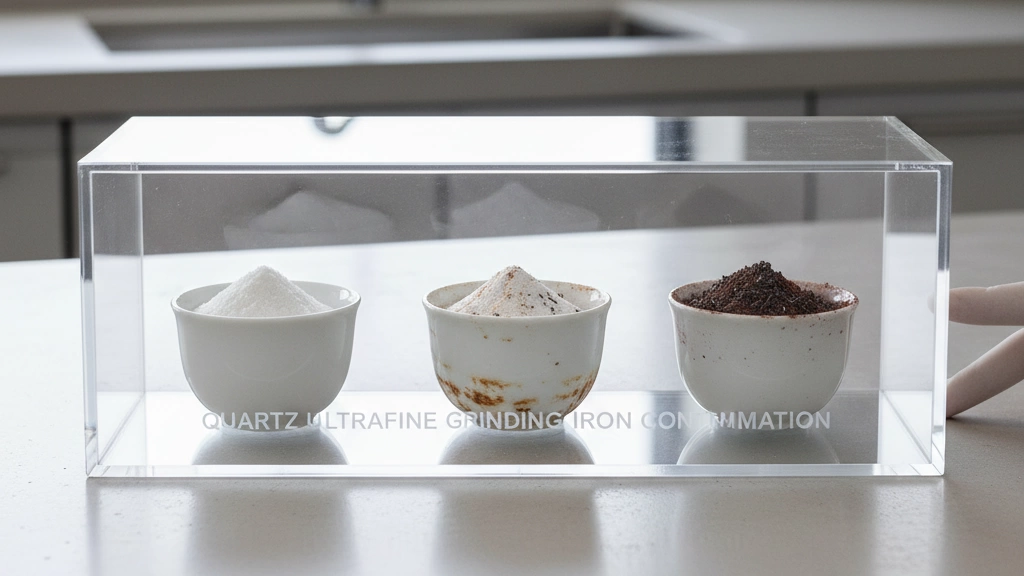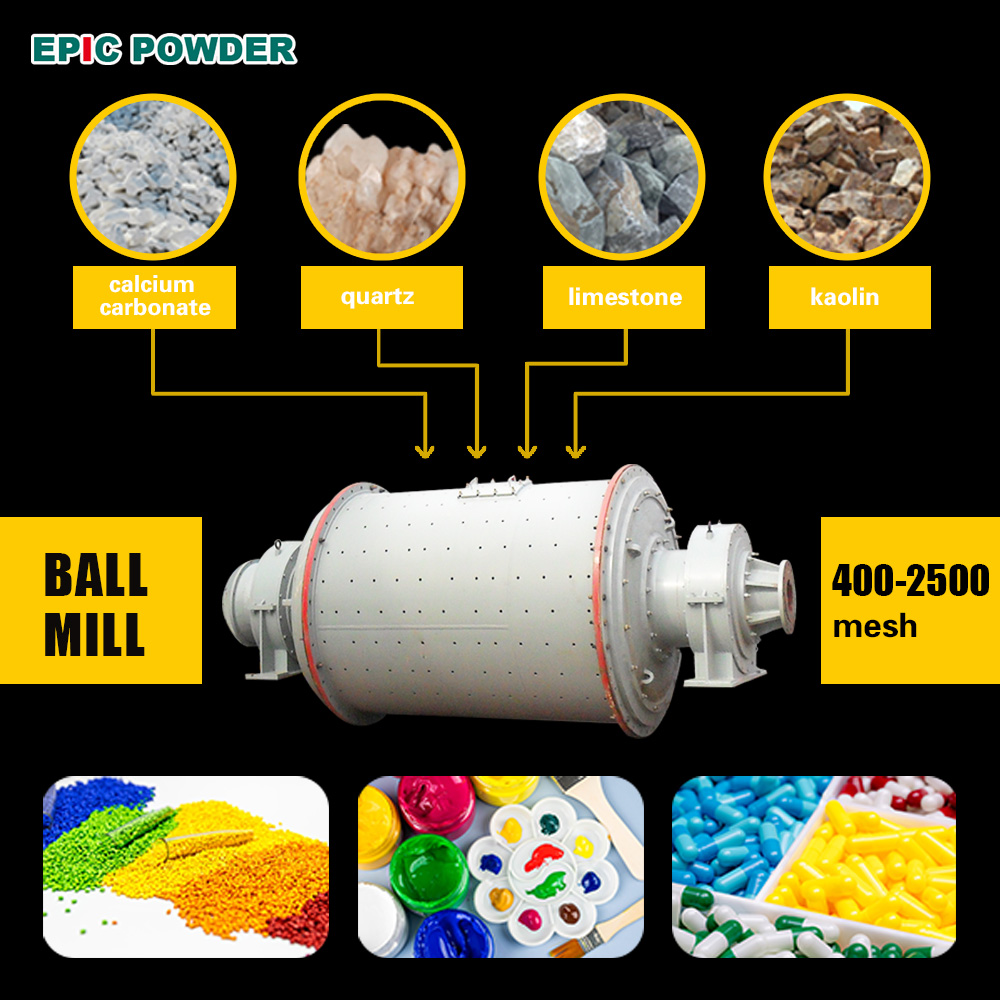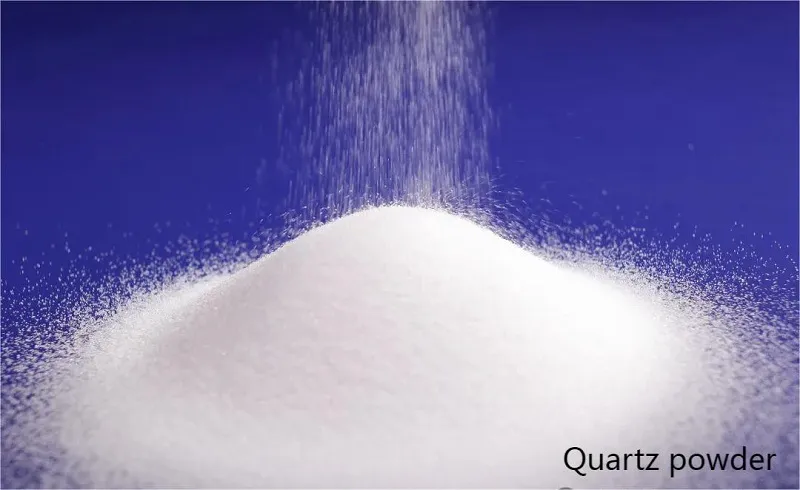What “Ultrafine” Really Means for Quartz Powder
When discussing ultrafine quartz powder, understanding particle size metrics like D50 et D97 is essential. Ultrafine quartz powder’s narrow PSD, especially at D97, is key for high-performance materials. It ensures minimal variation, which is critical for electrical insulation, optical clarity, and mechanical strength:
D50 (median diameter) means 50% of particles are smaller than this size.
D97 means 97% of particles fall below this size—critical for defining ultrafine quality.
Industrial ultrafine quartz typically targets D97 in the 2–15 μm range, depending on end-use. This tighter size distribution ensures consistent performance in demanding applications such as semiconductors, optics, and engineered stone.
Quartz Powder Particle Size Categories
| Grade | Typical D97 Size (Μm) | Typical D50 Size (Μm) | Common Applications |
| Coarse Quartz | >50 | 30–50 | Glass batch, foundry sand |
| Microfine Quartz | 15–50 | 7–20 | Paint fillers, construction |
| Ultrafine Quartz | 2–15 | 1–7 | Semiconductors, precision ceramics |
Key Differences vs Coarse and Microfine Quartz
| Aspect | Coarse Quartz | Microfine Quartz | Ultrafine Quartz |
| Particle Size (D97) | 50 μm | 15–50 μm | 2–15 μm |
| Surface Area | Faible | Moderate | High (enhances reactivity) |
| Application Precision | Faible | Moyen | High (stringent process control) |
In “ultrafine” for quartz means achieving D97 between 2 and 15 microns with tight control over distribution—not just reducing average particle size but also eliminating coarse tailing. This level of fineness distinguishes ultrafine grades from conventional quartz powders in industrial use.
Why Iron Contamination Is the #1 problem in Quartz Ultrafine Grinding

Iron contamination is the biggest challenge when grinding quartz powder ultrafine. Even trace amounts of iron—just a few parts per million (ppm)—can severely damage the electrical and semiconductor properties of high-purity silica. This is critical for industries like semiconductors, where purity directly affects product performance and yield.
Traditional steel ball mills are a major source of iron contamination. During grinding, the steel media and liners wear down, releasing Fe particles into the quartz powder. This level of contamination is simply unacceptable in ultrafine quartz processing.
The proven solution is using ceramic-lined mills combined with 99.9% alumina balls. Ceramic linings and alumina grinding media minimize iron wear and keep contamination ultralow. This approach protects the quartz powder’s purity without sacrificing grinding efficiency. For more on specialized grinding setups, check out our insights on ceramic-lined ball mills for zircon sand processing.
Proven Technologies for Quartz Ultrafine Grinding
When it comes to producing ultrafine quartz powder, several technologies stand out, each with unique strengths and trade-offs. At Poudre épique, we focus on proven solutions that deliver low contamination, precise particle size control, and cost-effective operation.
1 Ceramic-Lined Ball Mill + High-Precision Air Classifier (Closed Circuit)
This is Poudre épique’s flagship system for ultrafine quartz grinding. The ceramic-lined ball mill prevents iron contamination, while the closed-circuit loop with a high-precision quartz air classifier ensures a tight particle size distribution, typically achieving D97 from 2 to 15 μm efficiently. This setup balances energy consumption and throughput and consistently produces high-purity fine quartz powder used in demanding applications.
2 Fluidized Bed Jet Mill
The fluidized bed jet mill uses high-velocity air streams to grind quartz particles without mechanical contact, resulting in virtually iron-free powder. It excels at reaching extremely fine sizes (below 5 μm), but its energy consumption and operational cost are typically higher than ball mill systems, especially at larger production scales.
3 Vertical Stirred Mill (IsaMill, SMD, etc.)
Vertical stirred mills deliver ultrafine grinding with high energy efficiency and reduced wear. They are notable for handling abrasive materials like quartz well, offering good capacity and fine particle control. While contamination is minimal compared to traditional ball mills, they usually require ceramic or alumina grinding media to maintain low iron content.
4 Horizontal Stirred Mill
Similar to vertical mills, horizontal stirred mills provide efficient fine grinding with tight particle size distribution. They are often applied for specialty quartz powders requiring median particle sizes in the low microns range. Keeping contamination low depends on the lining and grinding media choices.
Technology Comparison at a Glance
| Technology | Capacity (T/Hr) | Fineness (D97, Μm) | Iron Contamination | Consommation d'énergie | Cost (CapEx + OpEx) |
| Ceramic-Lined Ball Mill + Classifier | Medium (1-10) | 2–15 | Very Low (ppm-level) | Moderate | Moderate |
| Fluidized Bed Jet Mill | Low-Medium (0.5-5) | 1–5 | Near Zero | Haut | Haut |
| Vertical Stirred Mill | Medium (1-8) | 1–10 | Faible | Moderate | Moderate-High |
| Horizontal Stirred Mill | Low-Medium (0.5-6) | 2–10 | Faible | Moderate | Moderate |
In the ceramic-lined ball mill combined with a high-precision quartz air classifier delivers the best overall balance of purity, capacity, fineness, and cost for ultrafine quartz powder production in the 2–15 μm range. For ultra-fine applications below 5 μm, fluidized bed jet mills or stirred mills may be preferred despite higher operating costs.
For more detailed insights on ceramic lining technology and closed-circuit grinding benefits, check out our article on the core process characteristics and uses of kaolin, which shares parallels relevant for quartz powder production.
Ceramic-Lined Ball Mill + Air Classifier System

The ceramic-lined ball mill combined with a high-precision air classifier works as a closed-circuit grinding system designed specifically for producing ultrafine quartz powder in the 2–10 μm range. Here’s how it plays out:
Closed-circuit loop: The quartz feed enters the ceramic-lined ball mill, where grinding reduces particle size. The powder then moves to the air classifier, which separates fine particles that meet the target size (e.g., D97 at 10 μm, 5 μm, or even 3 μm) and sends coarser particles back to the mill for further grinding. This continuous loop ensures consistent particle size distribution while minimizing overgrinding.
Cost efficiency compared to jet mills: For producing quartz powder between 2 and 10 microns, this system beats fluidized bed jet mills on cost-per-ton basis. Jet mills consume significantly higher energy and require more costly maintenance. Meanwhile, the ball mill + classifier setup offers lower operating expenses without sacrificing product fineness or quality.
Particle size distribution examples: Real PSD curves from Epic Powder’s plants show sharp cutoffs at D97 values of 10 μm, 5 μm, and even ultra-pure 3 μm ultrafine quartz powder, demonstrating how versatile and precise the system can be.
Energy consumption: Tests indicate the ceramic-lined ball mill with air classifier uses roughly 30–50% less energy than an equivalent jet mill for the same particle fineness, helping reduce carbon footprint and operational cost.
Durability of alumina lining: The mill’s lining is made from 99.9% pure alumina ceramic. This material delivers excellent wear resistance, with lining lifetimes lasting thousands of operating hours before replacement is necessary. The low wear rate not only reduces downtime but also keeps iron contamination at bay, crucial for high-purity quartz powder.
If you want to explore maintenance and care tips for these specialized ball mills, our detailed guide on maintenance and care of ball mills is a helpful resource to ensure long-term performance and minimal downtime.
This combination of a ceramic-lined ball mill and quartz air classifier system is a proven technology for ultrafine grinding that balances precision, contamination control, energy efficiency, and cost-effectiveness—ideal for high-purity quartz powder production lines.
Key Process Parameters You Must Control
Controlling the right process parameters is vital for consistent ultrafine quartz powder quality, especially when targeting a tight D97 range like 2–10 μm. Here’s what you need to focus on:
| Parameter | Why It Matters | Typical Range / Notes |
| Ball Size & Grading | Influences grinding efficiency and particle size distribution. Larger balls break coarse particles; smaller balls polish fines. | Mix of 10–40 mm balls is common; optimize grading to balance throughput and fineness |
| Mill Speed & Filling Ratio | Affects energy input and grinding media movement. Too slow = poor grinding; too fast = excessive wear and impact. | Speed typically 65–75% of critical speed; filling ratio around 30–40% volume |
| Classifier Wheel Speed & Air Volume | Controls cut size and particle separation. Higher wheel speed and air volume lead to finer D97 but lower throughput. | Wheel speed adjustable from 3,000 to 9,000 RPM; air flow must match wheel speed for balance |
| Feeding Rate | Impacts grinding steady-state and classification efficiency. Overfeeding causes overgrinding and fines loss; underfeeding wastes capacity. | Usually 70–90% of max design capacity for stable operation |
| Moisture Content | Excess moisture clogs mill and classifier, reduces grinding efficiency, increases wear. Dry quartz powder (<0.5% moisture) is preferred. | Moisture below 0.3% ideal; >0.5% may require pre-drying |
Why Control These Matters?
Ball size & grading tune grinding energy to get the right crystal fracture without overgrinding.
Mill speed & filling ratio maintain effective media motion; too low wastes energy, too high risks lining damage.
Classifier settings define your product size sharply; incorrect settings yield broad PSD or off-spec fines.
Feeding rate keeps the system balanced so the closed circuit doesn’t overload or starve.
Moisture hampers airflow and can stick particles, spoiling both grinding and classification stages.
To achieve consistent ultrafine quartz powder, these parameters require precise monitoring and adjustment. Modern grinding lines often include automated control of classifier wheel speed and feed rate to maintain target D97 values.
For reference on equipment tailored to these parameters, check our range of ceramic lined ball mills with quartz air classifier systems, designed specifically for low-contamination, tight-size distribution quartz ultrafine grinding.
Applications of Ultrafine Quartz Powder (D97 ≤ 10 μm)

Ultrafine quartz powder with a D97 of 10 μm or less opens up a wide range of high-value applications where particle size and purity are critical.
High-Purity Silica for Semiconductor Crucibles: Sub-10 micron quartz powder is essential for making semiconductor-grade crucibles. The ultrafine powder ensures excellent melting behavior and minimal contamination, crucial for electronics manufacturing.
Fused Silica for 5G Radomes and Optical Fiber: Ultrafine quartz is widely used in fused silica production for 5G radomes thanks to its low dielectric loss and high transparency. Similarly, optical fibers benefit from the fine particle size and purity, resulting in better signal transmission.
Engineered Stone and Quartz Surfaces: The 2–10 μm silica powder improves texture, hardness, and aesthetic qualities in engineered stone countertops and quartz surfaces, delivering a premium finish with durability.
Precision Ceramics and EMC Fillers: Ultrafine quartz powder enables the production of precision ceramics with high strength and controlled properties. It also serves as an effective filler in electromagnetic compatibility (EMC) materials to ensure performance in electronic devices.
Paints, Coatings & Adhesives: Fine quartz powder enhances scratch resistance, viscosity control, and UV durability in paints and coatings. Adhesives also benefit from improved bonding and stability with ultrafine silica fillers.
These applications highlight why controlling particle size distribution and contamination levels is vital to achieving performance standards. For more details on grinding and classification options ideal for producing such ultrafine quartz powder, consider exploring advanced ball milling and mineral processing technologies tailored for high purity powders.
Case Studies & Real Results (Epic Powder Projects)
Epic Powder has delivered proven results across multiple ultrafine quartz grinding projects worldwide. Here are a few highlights showcasing our expertise in meeting strict particle size distribution (PSD) and iron contamination targets:
10 μm Quartz Powder Line in Shandong
This production line runs at a steady capacity of 15,000 tons per year, supplying ultrafine quartz powder with a D97 close to 10 μm. The closed-circuit ceramic-lined ball mill and air classifier system reduced iron contamination from 30 ppm in the raw feedstock down to under 5 ppm, ideal for engineered stone and high-quality coatings. The consistent PSD ensures excellent product performance across applications.
5 μm High-Purity Silica for Photovoltaic Glass
For photovoltaic glass manufacturers, purity and fineness are critical. Epic Powder’s fluidized bed jet mill technology delivered a stable D97 of 5 μm silica powder with Fe content below 3 ppm. This low-contamination ultrafine quartz powder significantly boosts the glass’s transparency and strength, meeting stringent solar industry standards.
3 μm Semiconductor-Grade Silica Project
Semiconductor applications demand ultrapure quartz powder with highly controlled particle sizes. Our customized vertical stirred mill system produced quartz powder at a D97 of 3 μm, with Fe levels consistently under 1 ppm. This project supports the manufacturing of crucibles and wafers where electrical and optical properties cannot be compromised.
Each of these projects underscores how Epic Powder’s tailored solutions optimize quartz ultrafine grinding for different industrial needs. For more technical insights into our ceramic-lined ball mill systems, visit our ball mill solutions page. Detailed case reviews are available on our project case studies page.
How to Choose the Right Ultrafine Grinding Equipment Supplier
Selecting the right supplier for your ultrafine quartz grinding equipment is critical to ensuring consistent quality, low contamination, and long-term performance. Here are 8 red flags to watch out for — and 8 must-have features you should demand:
| 8 Red Flags | 8 Must-Have Features |
| No clear info on ceramic lining specs | Detailed ceramic lining thickness data (≥15 mm) |
| Oversells ultra-low contamination without proof | Proven classifier precision for sharp PSD control |
| Lack of real particle size distribution charts | Transparent D97 performance guarantees |
| No references or case studies | Solid after-sales support and spare parts availability |
| Poor communication and slow replies | Customizable closed-circuit grinding solutions |
| No maintenance or wear rate data | Energy-efficient mill designs with alumina ball optio |
| Claims of “iron-free” without lab tests | Detailed contamination control strategies |
| No clear warranty on ceramic linings | Experienced technical team for setup and optimization |
Why Ceramic Lining Thickness Matters
The thickness and quality of the ceramic lining in ball mills directly affects contamination levels and wear life. Thicker alumina linings (around 15 mm or more) mean less iron contamination and longer service life, reducing downtime and maintenance costs.
Classifier Precision Makes a Difference
The precision of the quartz air classifier system determines how well the particle size is controlled, directly impacting your product’s D97 specification. High-quality classifiers help you hit tight specs consistently, especially in the 2–10 μm range.
Don’t Skip After-Sales Support
Ultrafine grinding systems require regular maintenance. A supplier offering strong after-sales support — including spare parts, technical troubleshooting, and timely response — will save you from costly production delays.
For more insight on balancing ceramic-lined ball mills with precision classifiers, check the detailed comparison of ultrafine grinding technologies and their contamination control strategies on our page about ultrafine grinding technology and uses.
Choosing the right supplier with these criteria ensures your quartz powder production stays competitive, clean, and efficient.
Frequently Asked Questions on Quartz Ultrafine Grinding
Can I reach D97 2 μm with ball mill + air classifier?
Reaching a D97 of 2 μm using a ceramic-lined ball mill plus air classifier is challenging but possible with precise control over parameters like ball size distribution, mill speed, and classifier settings. However, this setup is generally most efficient for the 5–15 μm range. For ultra-ultrafine grinding below 3 μm, fluidized bed jet mills or vertical stirred mills often perform better. Learn more about optimizing ball mill performance in our detailed guide on key factors affecting the specific surface area of powders.
Is a quartz fluidized bed jet mill really iron-free?
Jet mills use high-speed compressed air or gas and have no moving metal parts contacting the quartz, making them virtually free from iron contamination. This is critical for high-purity silica powder used in semiconductors or electronics. That said, system wear and feedstock purity still influence overall contamination. For comparison, ceramic-lined ball mills with alumina grinding media offer very low iron levels but not zero.
What is a typical ROI timeline for a 10,000 t/year quartz powder production line?
Return on investment often depends on product quality, scale, and market demand. A well-optimized closed-circuit ball mill plus air classifier system capable of producing 2–10 μm quartz powder can usually pay back within 2–3 years due to lower energy costs and minimal contamination leading to premium pricing. Jet mill systems might have higher upfront costs but provide better ultrafine precision, affecting ROI differently.
What is the maintenance schedule for ceramic lining in ball mills?
Ceramic linings, especially those made with 99.9% alumina, have excellent wear resistance but still require regular inspection. Typically, lining inspections occur every 6–12 months depending on throughput and abrasion levels. Proactive maintenance ensures consistent low iron contamination and grinding efficiency. When worn, lining replacement usually takes a couple of days with minimal downtime. For deeper insights, check out our article on the key benefits of using a ball mill grinding machine.
If you have more questions about ultrafine quartz powder production or equipment choices, feel free to reach out us at Poudre épique—helping you achieve the perfect D97 particle size and low contamination is our priority.

Merci de votre lecture. J'espère que cet article vous sera utile. N'hésitez pas à laisser un commentaire ci-dessous. Vous pouvez également contacter le service client en ligne d'EPIC Powder. Zelda pour toute autre question.
— Jason Wang, Ingénieur principal
